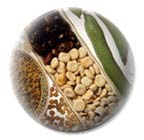- Home
- Introductions

|
Vegetable Seed Production
Cantaloupe :: Watermelon
:: Cucumber :: Pumpkin
|
 |
In addition to reading the information in this section,
please view this narrated video
on Cucurbit seed production (The video will open in a new window.) |
 |
Common Name: Cantaloupe
and mixed melons Scientific Name: Cucumis melo Family: Cucurbitaceae |
Cantaloupe introduction & history
There are two important Groups (formerly botanic varieties) classified under Cucumis melo. The Group Inodorus contains the so called "winter melons" like Casaba, Persian, Canary, Honeydew, Crenshaw, and Santa Claus that do not abscise from the vine at maturity, lack heavy netting, are generally less aromatic, and have slightly longer storage life than the Reticulatus group. One exception to this description is that the Crenshaws have a short shelf life and can be very odoriferous. The Group Reticulatus contains both western shipping and eastern shipping cultivars of muskmelon. The term muskmelon is preferred to cantaloupe which more correctly refers to the Cantalupensis Group of Cucumis melo that is generally not grown in the US. In recent years, the term cantaloupe is sometimes used in the vegetable trade to refer to the western shipping cultivars of muskmelon like PMR 45 and Topscore, while muskmelon is used by tradesmen to refer to larger fruited eastern cultivars. Reticulatus and Inodorus can freely cross and this is how the cultivar honeyloupe was created.
Please note that netted and winter melons are in the same genus as cucumber
so a number of characteristics for these crops are similar. Commercial
types are warm-season (frost sensitive) annuals that are cross pollinated
by bees. Sex expression is andromonoecious. Commercial plants are day-neutral.
Plant habit is vining with varied internode length.
Melons appear indigenous to Africa. Truly wild forms found only in eastern
tropical Africa (south of Sahara). Related wild forms reported are reported
in India, are likely undomesticated escapes derived from local cultivars.
Once domesticated, melon diversity expanded into numerous cultivars, especially
in India (considered a secondary center of origin). Cultivars were rapidly
dispersed throughout Europe and fairly early into the Americas.
Presently grown fruit probably shares same main characteristics of earlier cultivars although greatly improved for uniformity, size, shape, flesh thickness, and quality. Strongest contribution to commercial melon development from Colorado, i.e., Rocky Ford strains (dev. from Netted Gem, intro by Burpee from France about 1880). Transport of fruit of no importance until after 1900.
Cantaloupe Seed Production and Identification page
 |
Common Name: Watermelon |
Watermelon introduction & history
Watermelon is another cucurbit that is familiar to most students. Some cultivars are suited for specific production regions and uses. Watermelon is a warm season, frost sensitive, annual crop that matures ripe fruit from 75 to 110 days after planting. Watermelons are monoecious and require bees to pollinate. Watermelon plants have distinctive deeply lobed leaves. Although there are short internode bush cultivars available, most commercial cultivars produce vines and need space to grow. Watermelons can be planted in rows or hills. As a general rule, rows are spaced 6 or 7 feet apart with hills (a group of seeds) containing 3 or 4 seeds each placed 3 to 4 feet apart within the rows. After emergence, hills are thinned to 2 or 3 plants per hill. Alternatively, seeds may be planted 4 to 6 inches apart in the row and later thinned to an in-row spacing of 1 plant per foot. Watermelons do not transplant well as bare-rooted plants. Seedless watermelons are transplanted from plugs because they germinate poorly in the field. In some areas such as Florida, watermelons are grown using drip irrigation and plasticulture mulch. In other regions, no mulch is used. For greatest productivity, watermelons should be irrigated. Texas produces the largest acreage of watermelons in the US followed by Florida. China is the largest producer of watermelons in the world.
Watermelon Seed Production and Identification page
 |
Common Name: Cucumber Scientific Name: Cucumis sativus Family: Cucurbitaceae |
Cucumber introduction & history
Commercial types are warm-season (frost sensitive) annuals
that are cross pollinated by bees. Some cultivars will
set fruit without pollination and are called parthenocarpic.
Parthenocarpic cultivars are commonly used for greenhouse production.
Sex expression varies with cultivar and is one of the most important characteristics
regarding cultivar selection. Commercial plants are day-neutral
but day length may alter sex expression as described below. Plant habit
is vining with varied internode length. Tendrils at each node help anchor
plants and allow plants to climb on supports. Flowers have 5 yellow petals
that are open for a single day.
Believed to have originated in India. Spread to China and Greece about 2000 years ago. Brought to Americas in 1494 and spread rapidly among native people. Wild cucumber plants grow in the Southeastern U.S.
Cucumber Seed Identification page |
Common Name:
Pumpkin and squash Scientific Name: Cucurbita pepo Family: Cucurbitaceae |
Pumpkin introduction & history
Pumpkin and squash are also members of the family Cucurbitaceae. Pumpkins are somewhat unique because many are used for ornamental purposes rather than eaten as a vegetable. Differences between pumpkin and squash have never been clearly or satisfactorily resolved. Culinary definitions are most often used and definitions based on botanical differences between pumpkin and squash have not been widely accepted. In some large pumpkin competitions, only C. pepo are considered as true pumpkins and all C. maxima are considered as squash but this is by no means universal.
Warm-season, frost sensitive annuals
Perennial